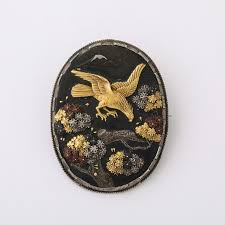Brief Notes on Shakudo
As with most Japanese metal coloring methods the techniques are metallurgically based rather than solution oriented; in the West we tend to use a myriad of coloring solutions and limited number of alloys; in Japan there are a limited number of coloring solutions and innumerable metal alloys which react differently in the same solution.
3 Minute Read
Shakudo is the Japanese term for a low gold content alloy which usually consists of between 2-7% gold and the rest copper. Sometimes small amounts of other metals are added. The usual alloy used and the one I've heard recommended most is a 3% gold alloy/rest copper. Shakudo obtains a durable, purplish black surface color when treated with a suitable solution. This is used to best effect when the shakudo surface is combined with inlays (mechanical or fusion) which then results in high contrast pattern options.
As with most Japanese metal coloring methods the techniques are metallurgically based rather than solution oriented; in the West we tend to use a myriad of coloring solutions and limited number of alloys; in Japan there are a limited number of coloring solutions and innumerable metal alloys which react differently in the same solution. Over the long haul the Japanese approach to my mind is the more sound one as there is little change in the surface colors with time by comparison with a Western often corrosion oriented coloring solutions. There are for example over fifty types of silver alloys in Japan which produce different shades of gray to white when treated.
It is of interest that recent developments in historical and archaeological research have pointed out that 'Shakudo' type alloys were introduced to Japan from the mainland after the 15th century AD and that upon re-examination of Egyptian, Roman and Greek artifacts there is strong evidence for genesis of the technique in that area and diffusion of the information eastwards. Use of the approach however died out in the West and so today with the re-introduction of the procedures to the West they are seen as a Japanese technology.
Solutions
- 6 grams copper sulfate
- 1/2 teaspoon table salt
- 850 ml water
- (use simmering/boiling) (Evans, page 248)
The following notes are from Untracht. I refer you to pages 671-672. The Japanese use Rokusho (Green-blue powder in Japanese from Untracht, 'crow gold' from a Japanese source) for coloring Shakudo. One can order a prepared powder from an address cited. Other formulas given include:
Rokusho No. 1
- 6g Copper acetate
- 2g Calcium carbonate (chalk)
- 2g Sodium hydroxide (lye)
- Dissolve in 150 ml of water in Pyrex ® container, let stand a week, siphon off clear liquid on top. When ready to use add 2g copper sulfate.
Rokusho No. 2
- 4g Copper acetate
- 1g Copper nitrate
- 1g Cupric Chloride
- 4g Copper Sulfate
- Dissolve in 1 liter of distilled water.
Rokusho No. 4
- 60g Copper acetate
- 60g Copper sulfate
- Vinegar diluteddiluted 4.5-12% with water 1/2 gal
Traditional application methods involve the preparation of about 1 pound of grated or ground up/blended white Oriental radish. 5 Parts of water are added to it. The Romans and Greeks are thought to have used rhubarb stalks and leaves for the same purpose. The object is hung on a copper wire and dipped into the Rokusho which is simmering in a deep copper pot, moved about, removed to check and after ten minutes or so when it is dark enough remove it and rub the grated radish over it gently (use gloves). Always keep the surface wet during all this to avoid water spots. The surface is then rubbed gently with baking soda and rinsed. This is repeated several times ending with the Rokusho boiling until you have the color you want. It is removed, gently dried and the surface is sealed. Traditionally this might be with an oil or a coat of wax applied to the warm metal. I might recommend turtle wax.
- Evans, Chuck, Jewelry: Contemporary Design and Technique, Davis publications, Worcester, Mass.
- Untracht, Oppi, Jewelry Concepts and Technology, Doubleday, New York, 1982
- Ard, William, "Studio MoKume", Metalsmith, Vol 1., #2 (Winter 1981), Society of North American Goldsmiths
- Pijanowski, Hiroko and Pijanowski, Eugene, "Update: MoKume-gane (woodgrain metal), Goldsmiths Journal, Vol 5, #1 (February 1979), Society of North American Goldsmiths.
You assume all responsibility and risk for the use of the safety resources available on or through this web page. The International Gem Society LLC does not assume any liability for the materials, information and opinions provided on, or available through, this web page. No advice or information provided by this website shall create any warranty. Reliance on such advice, information or the content of this web page is solely at your own risk, including without limitation any safety guidelines, resources or precautions, or any other information related to safety that may be available on or through this web page. The International Gem Society LLC disclaims any liability for injury, death or damages resulting from the use thereof.
Charles Lewton-Brain
Master goldsmith Charles Lewton-Brain trained, studied and worked in Germany, Canada and the United States to learn the skills he uses. Charles Lewton-Brain is one of the original creators of Ganoksin.
The All-In-One Jewelry Making Solution At Your Fingertips
When you join the Ganoksin community, you get the tools you need to take your work to the next level.
Trusted Jewelry Making Information & Techniques
Sign up to receive the latest articles, techniques, and inspirations with our free newsletter.
